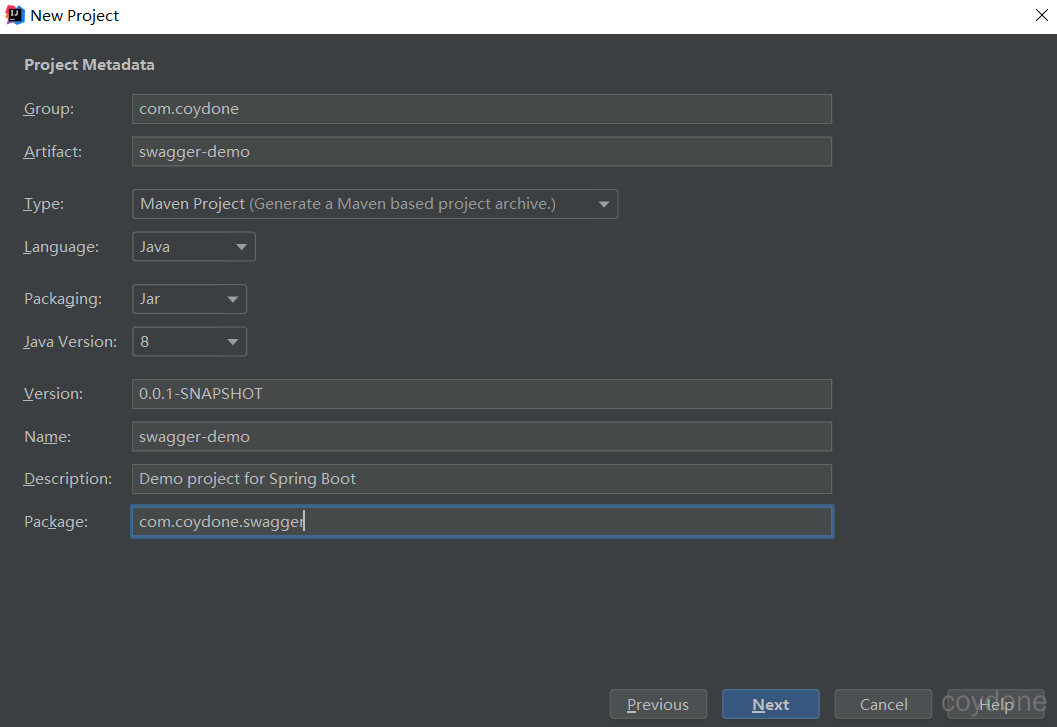Swagger产生背景
随着互联网技术的发展,现在的网站架构基本都由原来的后端渲染,变成了:前端渲染、先后端分离的形态,而且前端技术和后端技术在各自的道路上越走越远。 前端和后端的唯一联系,变成了API接口;API文档变成了前后端开发人员联系的纽带,变得越来越重要,swagger就是一款让你更好的书写API文档的框架,而且swagger可以完全模拟http请求,入参出参和实际情况差别几乎为零。
没有API文档工具之前,大家都是手写API文档的(维护起来相当困难),在什么地方书写的都有,有在confluence上写的,有在对应的项目目录下readme.md上写的,每个公司都有每个公司的玩法,无所谓好坏。但是能称之为“框架”的,估计也只有Swagger了。
Swagger介绍
Swagger 是一个规范和完整的框架,用于生成、描述、调用和可视化 RESTful 风格的 Web 服务。
作用:接口的文档在线自动生成;功能测试。
-
号称世界上最流行的api框架
-
RestFul风格API文档在线自动生成工具=>API文档与API定义同步更新
-
直接运行,可以在线测试API接口
-
支持多种语言(如java、php等)
在项目中使用Swagger需要springfox;
-
Swagger2:Springfox Swagger2
SpringBoot集成Swagger
1、新建一个SpringBoot的Web项目

2、导入相关依赖
<dependency>
<groupId>io.springfox</groupId>
<artifactId>springfox-swagger-ui</artifactId>
<version>2.9.2</version>
</dependency>
<dependency>
<groupId>io.springfox</groupId>
<artifactId>springfox-swagger2</artifactId>
<version>2.9.2</version>
</dependency>
3、编写一个Hello工程
package com.coydone.swagger.controller;
//http://localhost:8080/hello
@RestController
public class HelloController {
@RequestMapping("/hello")
public String hello(){
return "hello";
}
}
4、配置Swagger,使用Config配置类
package com.coydone.swagger.config;
@Configuration
@EnableSwagger2 //开启Swagger2
public class SwaggerConfig {
}
5、访问http://localhost:8080/swagger-ui.html。

配置Swagger
Swagger的bean实例Docket源码
public class Docket implements DocumentationPlugin {
// 默认的组,对应页面中的default
public static final String DEFAULT_GROUP_NAME = "default";
public Docket(DocumentationType documentationType) {
this.apiInfo = ApiInfo.DEFAULT;
this.groupName = "default";
this.enabled = true;
this.genericsNamingStrategy = new DefaultGenericTypeNamingStrategy();
this.applyDefaultResponseMessages = true;
this.host = "";
this.pathMapping = Optional.absent();
this.apiSelector = ApiSelector.DEFAULT;
this.enableUrlTemplating = false;
this.vendorExtensions = Lists.newArrayList();
this.documentationType = documentationType;
}
}
// api信息
public class ApiInfo {
public static final Contact DEFAULT_CONTACT = new Contact("", "", "");
public static final ApiInfo DEFAULT;
private final String version;// 版本 1.0
private final String title;// 标题 Api Documentation
private final String description;// 描述 Api Documentation
private final String termsOfServiceUrl;// 服务条款路径 urn:tos
private final String license;// 许可证 Apache 2.0
private final String licenseUrl;// 地址:http://www.apache.org/licenses/LICENSE-2.0
private final Contact contact;// DEFAULT_CONTACT
private final List<VendorExtension> vendorExtensions;// new ArrayList()
......
static {
DEFAULT = new ApiInfo("Api Documentation", "Api Documentation", "1.0", "urn:tos", DEFAULT_CONTACT, "Apache 2.0", "http://www.apache.org/licenses/LICENSE-2.0", new ArrayList());
}
}
public class DocumentationType extends SimplePluginMetadata {
public static final DocumentationType SWAGGER_12 = new DocumentationType("swagger", "1.2");
public static final DocumentationType SWAGGER_2 = new DocumentationType("swagger", "2.0");
public static final DocumentationType SPRING_WEB = new DocumentationType("spring-web", "1.0");
}
我们只需在自己的配置类中按照它给我们提供的样式自定义。
package com.coydone.swagger.config;
import org.springframework.context.annotation.Bean;
import org.springframework.context.annotation.Configuration;
import springfox.documentation.service.ApiInfo;
import springfox.documentation.service.Contact;
import springfox.documentation.spi.DocumentationType;
import springfox.documentation.spring.web.plugins.Docket;
import springfox.documentation.swagger2.annotations.EnableSwagger2;
import java.util.ArrayList;
@Configuration
@EnableSwagger2 // 开启Swagger2
public class SwaggerConfig {
//配置了Swagger的Docket的bean实例
@Bean
public Docket docket(){
return new Docket(DocumentationType.SWAGGER_2).apiInfo(apiInfo());
}
//配置swagger信息 apiInfo
private ApiInfo apiInfo(){
//作者信息
Contact contact = new Contact("coydone", "https://www.coydone.com/", "coydone@163.com");
return new ApiInfo("coydone的SwaggerAPI文档",
"学习java,学习编程",
"1.0",
"https://www.coydone.com/",
contact,
"Apache 2.0",
"http://www.apache.org/licenses/LICENSE-2.0",
new ArrayList()
);
}
}
Swagger配置扫描接口
Docket.select()
//配置了Swagger的Docket的bean实例
@Bean
public Docket docket(){
return new Docket(DocumentationType.SWAGGER_2)
.apiInfo(apiInfo())
.select()
//RequestHandlerSelectors:配置要扫描接口的方式
//basePackage():指定要扫描的包 any():扫描全部 none():不扫描
//withClassAnnotation(RestController.class):扫描类上的注解,参数是一个注解的反射对象
//withMethodAnnotation(GetMapping.class):扫描方法上的注解
.apis(RequestHandlerSelectors.basePackage("com.coydone.swagger.controller"))
//paths():过滤什么路径
.paths(PathSelectors.ant("/coydone/**"))
//工厂模式
.build();
}
配置是否启动Swagger
public Docket docket(){
return new Docket(DocumentationType.SWAGGER_2)
.apiInfo(apiInfo())
//默认为true 启动Swagger,如果为false,则在浏览器中无法访问Swagger
.enable(false)
.select()
.apis(RequestHandlerSelectors.basePackage("com.coydone.swagger.controller"))
.build();
}
我只希望我的Swagger在开发环境中使用,在生产环境中不使用?
-
判断是不是生产环境:flag=false
-
注入enable(flag)
演示:在application.properties中
spring.profiles.active=dev
新建application-dev.properties →server.port=8081
新建application-pro.properties →server.port=8082
修改SwaggerConfig配置类
@Bean
public Docket docket(Environment environment){
//设置要显示的Swagger环境
Profiles profiles = Profiles.of("dev");
//判断是否处在自己设定的环境当中
boolean flag = environment.acceptsProfiles(profiles);
return new Docket(DocumentationType.SWAGGER_2)
.apiInfo(apiInfo())
.enable(flag)
.select()
.apis(RequestHandlerSelectors.basePackage("com.coydone.swagger.controller"))
//.paths(PathSelectors.ant("/coydone/**"))
.build();
}
http://localhost:8081/swagger-ui.html:开发环境可以访问。
http://localhost:8082/swagger-ui.html:生产环境不能访问。
配置API文档的分组
.groupName("A")
设置多个分组:多个Docket实例即可
@Bean
public Docket docket1(){
return new Docket(DocumentationType.SWAGGER_2).groupName("A");
}
@Bean
public Docket docket2(){
return new Docket(DocumentationType.SWAGGER_2).groupName("B");
}
@Bean
public Docket docket3(){
return new Docket(DocumentationType.SWAGGER_2).groupName("C");
}
API注释
package com.coydone.swagger.pojo;
import io.swagger.annotations.ApiModel;
import io.swagger.annotations.ApiModelProperty;
//给生成的文档加注释
//@Api(value="注释")
@ApiModel("用户实体类")
public class User {
@ApiModelProperty("用户名")
public String username;
@ApiModelProperty("密码")
public String password;
}
package com.coydone.swagger.controller;
@Api(tags = "hello 控制类")
@RestController
public class HelloController {
@GetMapping("/hello")
public String hello(){
return "hello";
}
//只要我们的接口中,返回值中存在实体类,它就会被扫描到Swagger中
@ApiOperation("post测试类")
@PostMapping("/user")
public User user(){
return new User();
}
//Operation接口,放在方法上
@ApiOperation("get测试类")
@GetMapping("/hello2")
public String hello2(@ApiParam("用户名") String username){
return "hello"+username;
}
}
总结:
1、我们可以通过Swagger给一些比较难理解的属性或者接口增加注释信息。
2、接口文档实时更新。
3、可以在线测试。
【注意点】在项目正式发布的时候,关闭Swagger。出于安全考虑。而且节省运行的内存。





评论区